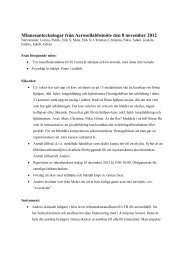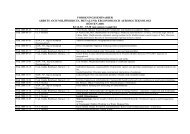ESTIMATING CLOUD DROPLET EFFECTIVE RADIUS ... - CAST
ESTIMATING CLOUD DROPLET EFFECTIVE RADIUS ... - CAST
ESTIMATING CLOUD DROPLET EFFECTIVE RADIUS ... - CAST
- No tags were found...
Create successful ePaper yourself
Turn your PDF publications into a flip-book with our unique Google optimized e-Paper software.
<strong>ESTIMATING</strong> <strong>CLOUD</strong> <strong>DROPLET</strong> <strong>EFFECTIVE</strong> <strong>RADIUS</strong> FROM SATELLITE REFLECTANCE DATAModified Exponential Approximation___________________________________________________________________________________________________larger absorption by Kokhanovsky et al. (2003, 2005a). The exponential approximation isbased on the asymptotic theory for diffusion, and made valid for the radiative transferequation for plane parallel water clouds with optical thickness τ > 10 (for quick first orderestimations and lower accuracy requirements it is applicable to clouds with optical thicknessas low as 5). It is basically a further simplification of the asymptotic equations (2.16 and2.17a,b) that allows faster computations, with an accuracy of 10-15% (depending on opticalthickness and viewing geometry). The use of the modified exponential approximation showsthat the errors in the computation of the reflection function is generally smaller than errorsrelated to uncertainties in the forward model and errors due to calibration uncertainties of theoptical instruments (Kokhanovsky and Nauss, 2006). Together with parameterizations of theradiative transfer solutions, the MEA was used by Kokhanovsky et al. (2005a) to deriveanalytical relationships of the reflection function that depend only on the effective radius.Their approach will be used in this study for retrieval of the cloud optical thickness andeffective radius and is here described in detail.In the exponential approximation parameters in Eq. (2.16) and (2.17b) are approximated byanalytical functions (ignoring the underlying surface albedo) assuming no or weak absorption:R∞0β( µ , µ0, φ ) = R ∞( µ , µ0, φ)− 4 K(µ ) K(µ0)(2.21)3(1 − g)⎛ β ⎞K( µ ) = K ⎜⎟0( µ )1−2α (2.22)⎝ 3(1 − g)⎠where (β = 1 - ω 0 ). For conservative scattering β = 0 and it follows that R ∞ = R 0 ∞ and K(µ) =K 0 (µ). In the visible with zero absorption the reflection function of Eq. (2.16) can thus bewritten∗t1(r , )[ 1 ] ( ) ( )0ew − Ag,1K0µ K0µ0R1( τc; µ , µ0,φ)= R ∞( µ , µ0, φ)−(2.23)1−A 1−t ( r , w)g,1[ ]where R * 1 is the (measured) reflectance, R 0 ∞ is the reflection function of an idealized semiinfinitenonabsorbing water cloud, A g,1 is the ground surface albedo in the nonabsorbingwaveband and t 1 is the diffused transmittance of a cloud. t 1 is governed by the effective radiusr e and the liquid water path w, but can be expressed in terms of asymmetry parameter g andoptical thickness τ 1 :1t1=(2.24)3α + τ1( 1−g1(r e))4where α is nearly constant at 1.072 for water clouds (Kokhanovsky et al., 2003; Kokhanovskyet al. 2005a). The liquid water path w is correlated to the optical thickness through theextinction coefficient (Kokhanovsky et al., 2003; Kokhanovsky et al. 2005a):τ = wk eλ,r )(2.25)(e1ewhereke1.5ρ ⋅ r⎛⎜1+⎝1.1=3e⎞( ) ⎟ 2 /k ⋅ re⎠(2.26)13




